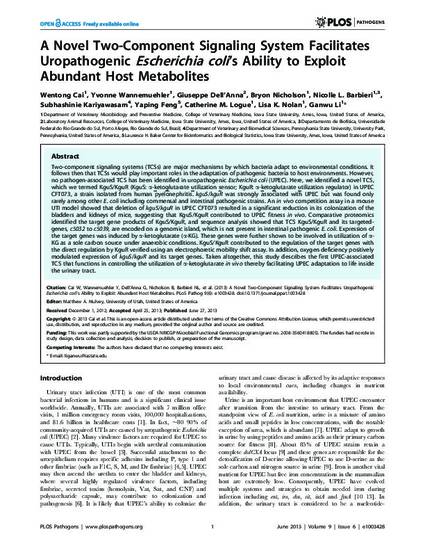
Article
A Novel Two-Component Signaling System Facilitates Uropathogenic Escherichia coli's Ability to Exploit Abundant Host Metabolites
PLoS Pathogens
Document Type
Article
Disciplines
Publication Date
6-27-2013
DOI
10.1371/journal.ppat.1003428
Abstract
wo-component signaling systems (TCSs) are major mechanisms by which bacteria adapt to environmental conditions. It follows then that TCSs would play important roles in the adaptation of pathogenic bacteria to host environments. However, no pathogen-associated TCS has been identified in uropathogenic Escherichia coli (UPEC). Here, we identified a novel TCS, which we termed KguS/KguR (KguS: α-ketoglutarate utilization sensor; KguR: α-ketoglutarate utilizationregulator) in UPEC CFT073, a strain isolated from human pyelonephritis. kguS/kguR was strongly associated with UPEC but was found only rarely among other E. coli including commensal and intestinal pathogenic strains. An in vivo competition assay in a mouse UTI model showed that deletion of kguS/kguR in UPEC CFT073 resulted in a significant reduction in its colonization of the bladders and kidneys of mice, suggesting that KguS/KguR contributed to UPEC fitness in vivo. Comparative proteomics identified the target gene products of KguS/KguR, and sequence analysis showed that TCS KguS/KguR and its targeted-genes,c5032 to c5039, are encoded on a genomic island, which is not present in intestinal pathogenicE. coli. Expression of the target genes was induced by α-ketoglutarate (α-KG). These genes were further shown to be involved in utilization of α-KG as a sole carbon source under anaerobic conditions. KguS/KguR contributed to the regulation of the target genes with the direct regulation by KguR verified using an electrophoretic mobility shift assay. In addition, oxygen deficiency positively modulated expression of kguS/kguR and its target genes. Taken altogether, this study describes the first UPEC-associated TCS that functions in controlling the utilization of α-ketoglutarate in vivo thereby facilitating UPEC adaptation to life inside the urinary tract.
Rights
© 2013 Cai et al. This is an open-access article distributed under the terms of the Creative Commons Attribution License, which permits unrestricted use, distribution, and reproduction in any medium, provided the original author and source are credited.
Copyright Owner
Cai et al
Copyright Date
2013
Language
en
File Format
application/pdf
Citation Information
Wentong Cai, Yvonne Wannemuehler, Giuseppe Dell'Anna, Bryon A. Nicholson, et al.. "A Novel Two-Component Signaling System Facilitates Uropathogenic Escherichia coli's Ability to Exploit Abundant Host Metabolites" PLoS Pathogens Vol. 9 Iss. 6 (2013) p. e1003428 Available at: http://works.bepress.com/lisa_nolan/82/

This article is from PLoS Pathogens 9 (2013): e1003428, doi:10.1371/journal.ppat.1003428. Posted with permission.